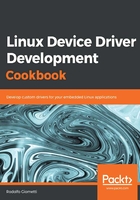
What this book covers
Chapter 1, Installing the Development System, presents how to install a complete development system based on Ubuntu 18.04.1 LTS, along with a complete testing system based on the Marvell ESPRESSObin board. The chapter will also present how to use the serial console and how to recompile the kernel from scratch, and will teach you some tricks for performing cross-compilations and software emulations.
Chapter 2, A Peek Inside the Kernel, discusses how to create a custom kernel module, and how to read and manage kernel messages. Both of these skills are very useful for helping the developer to understand what is happening inside the kernel.
Chapter 3, Working with Char Drivers, examines how to implement a really simple char driver, and how to exchange data between it and the userspace. The chapter ends by proposing some examples in order to underline the Everything is a file abstraction against a device driver.
Chapter 4, Using the Device Tree, presents the device tree. The reader will learn how to read and understand it, how to write a custom device tree and then how to compile it in order to get a binary form that can be passed to the kernel. The chapter ends with a section about downloading firmware (within a peripheral) and how to configure the CPU's pins by using a Pin MUX tool. Examples are provided using the Armada 3720, i.Mx 7Dual, and SAMA5D3 CPUs.
Chapter 5, Managing Interrupts and Concurrency, looks at how to manage interrupts and concurrency within the Linux kernel. It shows how to install an interrupt handler, how to defer a job to a later time, and how to manage kernel timers. At the end of the chapter, the reader will learn how to wait for an event (such as waiting for some data to be read) and how to protect their data against race conditions.
Chapter 6, Miscellaneous Kernel Internals, discusses how to dynamically allocate memory inside the kernel, and how to use several helper functions that are useful for several everyday programming actions (such as strings manipulations, lists, and hash tables manipulations). The chapter will also introduce how to do I/O memory access, and how to safely spend time within the kernel in order to create well-defined busy loop delays.
Chapter 7, Advanced Char Driver Operations, presents all the advanced operations that are available on character drivers: ioctl(), mmap(), lseek(), the poll()/select() system calls implementation, and asynchronous I/O via the SIGIO signal.
Appendix A, Additional Information: Working with Char Drivers, This contains additional information on chapter 3.
Appendix B, Additional Information: Using the Device Tree, This contains additional information on chapter 4.
Appendix C, Additional Information: Managing Interrupts and Concurrency, This contains additional information on chapter 5.
Appendix D, Additional Information: Miscellaneous Kernel Internals, This contains additional information on chapter 6.
Appendix E, Additional Information: Advanced Char Driver Operations, This contains additional information on chapter 7.